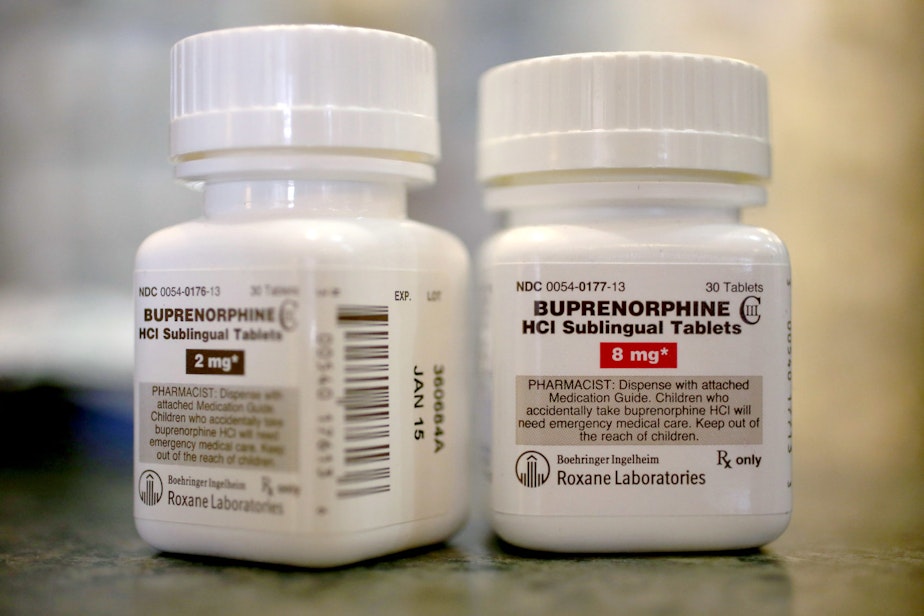Doctor Says Shutdown May Force Him To Turn Away Patients Addicted To Opioids

Senate Minority Leader Chuck Schumer (D-N.Y.) warned over the weekend that the shutdown could soon impact the treatment of patients addicted to opioids.
Doctors treating those patients have to get approval from the now-shuttered Drug Enforcement Administration if they want to prescribe Suboxone, a drug used in conjunction with other therapies to manage opioid addiction. Doctors who want to prescribe the medication to more patients also have to get approval from the federal government.
Dr. Anthony Martinez, with the Erie County Medical Center in Buffalo, New York, tells Here & Now‘s Robin Young he is about to reach his limit of how many patients he can subscribe Suboxone. In that case, he would have to get a waiver — or start turning patients away.
“As of today, we have 97 patients currently on therapy, and we have six patients that are waiting, but we’re quickly obviously coming up against that 100-patient cap,” Martinez says. “We have submitted the waiver, but now it hinges on the DEA’s approval.”
The barriers to care presented by the government shutdown come after the number of opioid deaths in Erie County fell last year. But last weekend alone, there were several overdoses in a 48-hour period, Martinez says.
Sponsored
“We suspect that there was a load of heroin that was cut with fentanyl, and we had nine overdoses with three deaths,” he says.
Interview Highlights
On how Suboxone is used to treat opioid addiction
“Suboxone is a combination of buprenorphine and naloxone, the same medication that we utilize to actually reverse the effect of opiate. When taking appropriately, your body doesn’t actually absorb the naloxone part. When it activates your opiate receptors in your body, it only partially activates them. So it prevents cravings, but there is a low risk of overdose potential.
“It helps to prevent the acute abstinence period when they may be in withdrawal, but with long-term use it also helps to prevent cravings. So one of the things that we utilize is medication-assisted therapy, such as Suboxone and buprenorphine, in conjunction with other modalities, such as behavioral therapy and group therapy, etc.”
Sponsored
On alternative treatment methods if Martinez reaches the cap
“We’re very mindful of the cap. That said we also don’t want to turn patients away. There’s other options for medically assisted therapy, but one of which is methadone. The problem is that there’s very few clinics in our area for methadone, and there’s a long wait list. There’s a medication called Vivitrol, which is an injectable form of naltrexone. But the problem with that is that patients often have to be abstinent from any opiate for anywhere between seven to 14 days. And for a lot of patients, that’s an eternity. It’s a long time to wait. We’ve had some community support in some of the providers that have come forward and willing to utilize spots on their own waivers to help us while we’re in this situation.”
On the decline in opioid deaths in the county last year
“It’s a multifactorial reason why that number is on the decline. There’s been a huge commitment by the county, by the state to educate patients and educate providers to provide naltrexone kits. We’ve seen an uptake in the number of physicians applying for waivers. But the initial cap is only 30 patients, so if you’re a new prescriber, in the first year you’re only allowed to treat 30 patients.”
Sponsored
On the reason for prescription caps
“When buprenorphine therapy began in around 2000, there was legislation that mandated an eight-hour training course, and then these restrictions came into play at that point. But it’s never really evolved as we have become more and more embedded in this opiate crisis, we still have these caps, which is seemingly backwards because when you consider that there is no caps on the number of patients that we’re allowed to treat with potentially addictive and potentially fatal opiate-based pain medications, yet we’re restricted on the amount of patients that we can treat with a medication that can help this problem with much less addiction and overdose potential. So it brings to light the bigger issue, which I think is why do we have these waiver guidelines to begin with?
“Any opiate-based pain medication, it could be abused. They were initially afraid that people would prescribe it incorrectly and precipitate opiate withdrawal. But there’s other medications such as Vivitrol that are available that carry the same risk, and there’s no restriction on that.”
Jill Ryan produced this interview and Kathleen McKenna edited it for broadcast. Samantha Raphelson adapted it for the web. [Copyright 2019 NPR]
